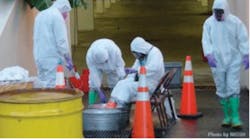A new free, web-based training released by the National Institute for Occupational Safety and Health (NIOSH) will help emergency responders and their managers better cope with the demands of emergency operations when deployed to a disaster site.
The 30-minute online training program, Interim NIOSH Training for Emergency Responders: Reducing Risks Associated with Long Work Hours, provides strategies to reduce the health and safety risks that are linked to working long hours during the daytime. Long work hours, coupled with the high physical and emotional strain associated with emergency response and recovery operations, can prevent responders from getting enough sleep. Insufficient sleep puts responders, and those around them, at risk for fatigue-related mistakes that can lead to injuries and death.
“Workers and their managers across many sectors – healthcare, public safety, utilities, construction, humanitarian aid and clean up services – need to address the importance of sleep and plan for it like other critical logistical items to carry out operations, such as having enough water, food, and supplies,” said NIOSH Director John Howard, M.D. “This training is an important resource to promote the health resilience among those who are on the front lines of a natural or man-made disaster.”
The training is designed to increase knowledge and promote better personal behaviors and workplace systems that will reduce the risks associated with working long hours. The training covers the following topics:
- Dangers of working while sleepy and fatigued.
- Basic information about sleep and fatigue.
- Personal factors that could lead to higher health and safety risks.
- Better work schedule design and other management strategies.
- Signs and symptoms of fatigue in response workers.
- Tips for improving sleep at night and alertness on the job.
- Preventing fatigue from strain to muscles and joints.
- Protecting from fatigue due to excessive heat.
The course is available on the NIOSH web site, as is additional information about NIOSH’s resources on emergency preparedness and response.
